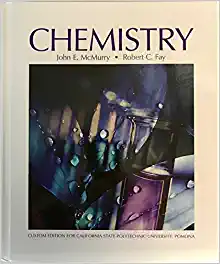Question
Summarize this piece ABSTRACT The reactions of pyridine alcohols PyCHCH(Ar)OH [Ar= Ph (1), 4-CHCH (2), 4-CICH (3)], and PyCH C(CH) OH (4) with Ru,(CO), in
Summarize this piece ABSTRACT
The reactions of pyridine alcohols PyCHCH(Ar)OH [Ar= Ph (1), 4-CHCH (2), 4-CICH (3)], and PyCH C(CH) OH (4) with Ru,(CO), in refluxing toluene gave a series of ruthenium carbonyl complexes PyCH = C(Ph)O] [PYCH = C(Ph))Ru(CO); (5) and [PyCHCH(Ph)O], Ru,(CO), (6), [PYCH = C(4-CHCH) O] Ru(CO), (7), [PYCHCH(4-CIC H)O] Ru,(CO), (8) and [PyCH C(CH)0]Ru(CO) (9) respectively. Five new complexes 5-9 were characterized by elemental analysis, IR, H NMR and PC NMR spectroscopy. The crystal structures of complexes 5-8 were determined by X-ray crystal diffraction analysis. Moreover, the re activity of complex 6 had been investigated, when 6 was treated with cyclopentadiene in refluxing toluene, dinuclear metal carbonyl complexes [0CH)Ru(CO)) (CO), (10) was obtained. Similar treatment of 6 with indene gave the product [(-C,H,)Ru(CO)],(u-CO), (11). 1. Introduction
The coordination chemistry of nitrogen donor ligands has been ex tensively studied and is mostly related to their relevance to biological systems [1]. Transition metal complexes of nitrogen-containing het erocyclic compounds such as pyridine, di- and poly-pyridine, azines and their derivatives are also of great interest due to their ability to undergo facile electrochemical processes. Furthermore, their abilities to absorb visible light act as electron reservoirs are promising factors in their applications as photosensitizers (2,3]. On the other hand, transition carbony! metal carbonyl complexes are very interesting for their reactivity in catalytic reactions such as as hydrogenation, hydroformylation and car bonylation [4-8). Moreover, metal carbonyl derivatives of nitrogen donor ligands are important routes to prepare interesting metal car bonyl complexes (9,10]. In our earlier communications, we reported the behaviour of several mono-dentate nitrogen donor ligands with Ru,(CO)12 [11-15]. Our interest in investigation of the reaction of Ru3(CO)12 with several nitrogen and oxygen donor ligands prompted us to investigate the reactions of Ru (CO)12 with some pyr idine derivatives. Here we describe the preparation and characteriza tion of some new ruthenium carbonyl derivatives containing bidentate pyridine-alkoxide ligands. 2. Experimental
2.1. General considerations
Schlenk and vacuum-line techniques were employed for all manip ulations. All solvents were distilled from appropriate drying agents under an argon dry atmosphere. 'H and 3C NMR spectra were recorded on Bruker AV 500 or Bruker Av III-600 instrument in CDC13, while IR spectra were recorded as KBr disks on a FT IR 8900 spectrometer. Elemental analyses were performed with a VarioEL. III analyzer. The different functional groups pyridine-containing alcohol ligands PyCHCH(Ar)OH [Ar = Ph (1), 4-CHCH (2), 4-C1 C6H (3)], and PyCHC(CH3)OH (4) were prepared by literature methods [16,17].
2.2. Synthesis of complexes [PYCH = C(Ph)O] [PyCH = C(Ph))Ru(CO)2 (5) and [PYCHCH(Ph)O] Ru (CO) (6)
A solution of ligand precursor PyCHCH(Ph)OH (1) (0.190 g, 0.938 mmol) and Rus(CO) 12 (0.300 g, 0.469 mmol) in toluene (30 mL) was refluxed for 6 h. After removal of solvent, the residue was chro matographed on an alumina column using petroleum ether/ethyl acetate as eluent. The first band (red) afforded 5 (0.080 g, 18.5% yield) as orange-red crystals. The second band (red) gave 6 (0.184 g, 42.5% yield) as orange-red crystals. For 5: M.p. 116.7 C. Anal. Calcd. for C28H20NO3Ru: C, 63.03; H, 3.78; N, 5.25. Found: C, 63.10; H, 3.85; N, 5.30. H NMR (500 MHz, CDC): 8 8.50 (d, 1H, J = 8.0 Hz, Py-H), 7.66-7.68 (m, 2H, Py-H), 7.57-7.61 (m, 2H, Py-H), 7.49-7.53 (m, 3H, Ph-H), 7.37 (t, 2H, J = 9.5 Hz, Py-H), 7.29-7.31 (m, 1H, Py-H), 7.23-7.26 (m, 4H, Ph-H), 7.01 (s, 1H, J = 10.5 Hz, Ph-H), 6.87 (s, 1H, -CH=CH-), 6.73-6.80 (m, 2H, Ph-H), 5.74 (s, 1H, -CH=CH-); C NMR(125 MHz, CDC13): 94.1, 116.5, 118.8, 121.4, 123.9, 125.7, 126.4, 126.6, 127.8, 128.0, 128.5, 131.1, 136.5, 138.3, 141.1, 147.5, 151.7, 154.1, 158.2, 167.1, 169.3, 195.0, 197.0, 199.7. IR (vco, KBr, cm-): 2029(s), 1948(s).
For 6: M.p. 192.3 C. Anal. Calcd. for C34H24N2O10Ru3: C, 44.20; H, 2.62; N, 3.03. Found: C, 44.28; H, 2.70; 3.13. H NMR (500 MHz, CDCI): 87.57 (t, 2H, J = 1.5 Hz, Py-H), 7.31-7.42 (m, 12H, Py-H, Ph H), 7.03 (d, 2H, J = 7.5 Hz, Ph-H), 6.70 (t, 2H, J = 6.5 Hz, Ph-H), 4.10 (d, 2H, J = 10.0 Hz, -CH-), 3.19-3.24 (m, 2H, -CH-), 2.85 (d, 2H, J = 16.0 Hz, -CH-); C NMR (125 MHz, CDCI3): 51.5, 77.3, 121.5, 124.3, 125.3, 126.3, 127.3, 136.6, 146.4, 154.0, 160.1, 193.2, 202.8, 202.9. IR (Dco, KBr, cm): 2067(s), 2001(s), 1984(s), 1918(s).
Step by Step Solution
There are 3 Steps involved in it
Step: 1

Get Instant Access to Expert-Tailored Solutions
See step-by-step solutions with expert insights and AI powered tools for academic success
Step: 2

Step: 3

Ace Your Homework with AI
Get the answers you need in no time with our AI-driven, step-by-step assistance
Get Started


